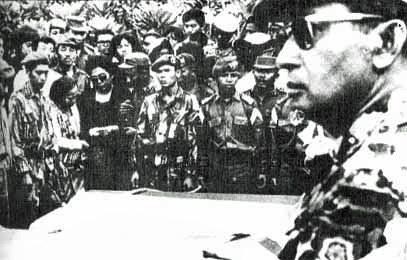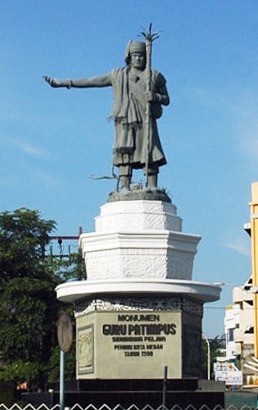|
Ahmad Husein
Colonel Ahmad Husein (1 April 1925 – 28 November 1998) was an Indonesian independence fighter and military leader of the PRRI. Forming the Revolutionary Government of the Republic of Indonesia (PRRI) 15, 1958, in Padang under the leadership of Syafruddin Prawiranegara. Early life Ahmad Husein was born in Padang on April 1, 1925 to Abdoel Kahar, a pharmacy owner, at the Padang military hospital. Ahmad has eleven siblings (7 boys, 4 girls). He attended Hollandsch-Inlandsche School Padang and graduated in 1938. After that he studied at Taman Siswa in Bukittinggi and graduated in 1941. In 1943, following the Japanese occupation of Indonesia, Ahmad Husein enrolled in Giyugun, a native volunteer force. Prior to Japan's surrender in the Pacific War, Ahmad became a member of the People's Security Agency (BKR) in Padang, actively recruiting people into the BKR. Ahmad became the combat commander of the Padang Area, which became known as the Kuranji Tiger. During the Indonesian war of i ... [...More Info...] [...Related Items...] OR: [Wikipedia] [Google] [Baidu] |
Revolutionary Government Of The Republic Of Indonesia
The Revolutionary Government of the Republic of Indonesia ( id, Pemerintah Revolusioner Republik Indonesia (PRRI)) was a revolutionary government set up in Sumatra to oppose the central government of Indonesia in 1958. Although frequently referred to as the PRRI/Permesta rebellion, the Permesta rebels were a separate movement in Sulawesi, that had pledged allegiance with the PRRI on 17 February 1958. Background: Rebellion of the colonels Prior to the establishment of the PRRI, there were several "rebellions" led by the various regional Army commanders in Sumatra. These events were the result of growing dissatisfaction with the Central Government and Indonesia's faltering economic development. The Central Government was seen by some in the outer islands (i.e. outside of Java) as disconnected from the Indonesian people. Some Army commands in the outer islands began covertly operating smuggling operations of Copra and contraband items to improve their financial position. These opera ... [...More Info...] [...Related Items...] OR: [Wikipedia] [Google] [Baidu] |
Indonesian War Of Independence
The Indonesian National Revolution, or the Indonesian War of Independence, was an armed conflict and diplomatic struggle between the Republic of Indonesia and the Dutch Empire and an internal social revolution during postwar and postcolonial Indonesia. It took place between Indonesia's declaration of independence in 1945 and the Netherlands' transfer of sovereignty over the Dutch East Indies to the Republic of the United States of Indonesia at the end of 1949. The four-year struggle involved sporadic but bloody armed conflict, internal Indonesian political and communal upheavals, and two major international diplomatic interventions. Dutch military forces (and, for a while, the forces of the World War II allies) were able to control the major towns, cities and industrial assets in Republican heartlands on Java and Sumatra but could not control the countryside. By 1949, international pressure on the Netherlands, the United States threatening to cut off all economic aid for ... [...More Info...] [...Related Items...] OR: [Wikipedia] [Google] [Baidu] |
Fall Of Sukarno
Indonesia's transition to the New Order in the mid-1960s ousted the country's first president, Sukarno, after 22 years in the position. One of the most tumultuous periods in the country's modern history, it was the commencement of Suharto's 31-year presidency. Described as the great ''dhalang'' ("puppet master"), Sukarno drew power from balancing the opposing and increasingly antagonistic forces of the army and Indonesian Communist Party (PKI). By 1965, the PKI extensively penetrated all levels of government and gained influence at the expense of the army. On 30 September 1965, six of the military's most senior officers were killed in action (generally labelled an "attempted coup") by the so-called 30 September Movement, a group from within the armed forces. Within a few hours, Major General Suharto mobilised forces under his command and took control of Jakarta. Anti-communists, initially following the army's lead, went on a violent purge of communists throughout the count ... [...More Info...] [...Related Items...] OR: [Wikipedia] [Google] [Baidu] |
Permesta
Permesta was a rebel movement in Indonesia, its name based on the Universal Struggle Charter (or ''Piagam Perjuangan Semesta'') that was declared on 2 March 1957 by civil and military leaders in East Indonesia. Initially the center of the movement was in Makassar, which at that time was the capital of the province of Sulawesi. However, support for the movement in South Sulawesi gradually dissipated, forcing the headquarters to move to Manado in North Sulawesi. On 17 February 1958, Permesta joined forces with the Revolutionary Government of the Republic of Indonesia (PRRI or ''Pemerintah Revolusioner Republik Indonesia'') based in Sumatra that declared a revolutionary government two days earlier. Following successful attacks by government forces ( TNI) from the Indonesian central government on the PRRI in Sumatra, the conflict swung to the east where the Permesta rebels were based. Manado was captured at the end of June 1958. However, the Permesta rebels continued their resistanc ... [...More Info...] [...Related Items...] OR: [Wikipedia] [Google] [Baidu] |
Djuanda Kartawidjaja
Raden Djuanda Kartawidjaja ( EYD: Raden Juanda Kartawijaya; 14 January 1911 – 7 November 1963), commonly known as Djuanda Kartawidjaja, usually referred to simply as Djuanda, was an Indonesian politician and ethnic Sundanese noble from the court of Cirebon, who served as the 11th and last Prime Minister of Indonesia. He previously served as Minister of Communications in seven cabinets from 1946 to 1949 and 1950 to 1953; as Minister of State in 1949 and Minister of Welfare from 1949 to 1950. Djuanda was Indonesia's final Prime Minister in the Sukarno "Karya" cabinets, the final cabinets of the Liberal Democracy Era (prior to the Guided Democracy period) and as First Minister from 1959 until his death in 1963. Djuanda's death and the abolition of the post of Prime Minister in the Indonesian Republican system allowed far greater power to be exercised by the President, now being given full ruling power with minimal oversight, as both Head of State and Head of Government. This ha ... [...More Info...] [...Related Items...] OR: [Wikipedia] [Google] [Baidu] |
Ventje Sumual
Herman Nicolas Ventje Sumual (11 June 1923 – 28 March 2010) was a military officer involved in the Indonesian National Revolution. His appointments include regional commander of KODAM VII/Wirabuana, but he is best known as the leader of the Permesta Permesta was a rebel movement in Indonesia, its name based on the Universal Struggle Charter (or ''Piagam Perjuangan Semesta'') that was declared on 2 March 1957 by civil and military leaders in East Indonesia. Initially the center of the movem ... movement. References * Matindas, Benny, and Supit, Bert (1998) ''Ventje Sumual, Pemimpin Yang Menatap Hanya Ke Depan: Biografi Seorang Patriot, Filsuf, Gembong Pemberontak (Ventje Sumual, a Leader that only Looks Forward: A biography of a Patriot, Philosopher, Rebel)'', Bina Insani, Jakarta {{DEFAULTSORT:Sumual, Ventje 1923 births 2010 deaths People from Manado Indonesian Christians Minahasa people People from Minahasa Regency Indonesian military personnel Indonesian re ... [...More Info...] [...Related Items...] OR: [Wikipedia] [Google] [Baidu] |
Maludin Simbolon
Colonel Maludin Simbolon (1916 – 2000) was an Indonesian military officer, independence fighter, and Minister of Foreign Affairs in the Revolutionary Government of the Republic of Indonesia's (PRRI) Cabinet. Background Maludin Simbolon was the second of ten children of his parents, Julius Simbolon and Nursiah Lumbantobing. His father worked as a plantation foreman in Pearaja, Tarutung, North Tapanuli Regency. Simbolon took his basic education at a Hollandsch-Inlandsche School Siantar Narumonda, then continued at Chr. Hollandsch Inlandsche Kweekschool (teacher school) Solo, Central Java, and graduated in 1938. There he met his future wife Paniyem in Solo, and from their marriage they had five children. Before the outbreak of World War II, he had taught as a teacher at HIS Solo, and also in Curup, Bengkulu. Military career Simbolon entered ''Giyūgun'' (義勇軍 ''giyūgun'', voluntary army) training during the Japanese Occupation, and afterward graduated as a Second Lieu ... [...More Info...] [...Related Items...] OR: [Wikipedia] [Google] [Baidu] |
Dharmasraya Regency
Dharmasraya Regency is a regency ''(kabupaten)'' of West Sumatra province, Indonesia. It covers an area of 2,961.13 km2 and had a population of 191,422 at the 2010 Census and 228,591 at the 2020 Census. The administrative centre is the town of Pulau Punjung. In the past, this regency was the location of an independent Kingdom of Dharmasraya, which came to power in the 11th century. Administrative districts Dharmasraya Regency is divided into eleven districts A district is a type of administrative division that, in some countries, is managed by the local government. Across the world, areas known as "districts" vary greatly in size, spanning regions or counties, several municipalities, subdivisions o ... (''kecamatan''), listed below with their areas and their populations at the 2010 Census and the 2020 Census.Badan Pusat Statistik, Jakarta, 2021. The table also includes the locations of the district administrative centres. References Regencies of West Sumatra [...More Info...] [...Related Items...] OR: [Wikipedia] [Google] [Baidu] |
PRRI Colorized By Colorbykevin ( id, Pemerintah Revolusioner Republik Indonesia, links=no), an alternative government established in Sumatra to oppose the Indonesian national government
{{disambiguation ...
PRRI may refer to: * Public Religion Research Institute, an education and research organization based in Washington, D.C. * Revolutionary Government of the Republic of Indonesia The Revolutionary Government of the Republic of Indonesia ( id, Pemerintah Revolusioner Republik Indonesia (PRRI)) was a revolutionary government set up in Sumatra to oppose the central government of Indonesia in 1958. Although frequently referr ... [...More Info...] [...Related Items...] OR: [Wikipedia] [Google] [Baidu] |
Central Sumatra
Central Sumatra ( id, Sumatra Tengah) was a province in Provinces of Indonesia, Indonesia whose territories included present day West Sumatra, Riau, Jambi, and the Riau Islands. Since 1957 this province has not been registered as an Indonesian province after it was dissolved by Emergency Law No 19/1957 and divided into the provinces of West Sumatra, Riau and Jambi through Law No 61/1958 by the Liberal democracy period in Indonesia, Sukarno government. History Establishment After the Indonesian independence, in the first session of the Regional National Committee (KND), the Province of Sumatra was then divided into three sub-provinces, namely: North Sumatra, Central Sumatra, and South Sumatra. Central Sumatra Province itself was an amalgamation of three administrative regions called residencies, namely: Riau Residency, West Sumatra Residency, and Jambi Residency. With the issuance of the Law No 10/1948 on 15 April 1948, it was stipulated that Sumatra was divided into three province ... [...More Info...] [...Related Items...] OR: [Wikipedia] [Google] [Baidu] |
Medan
Medan (; English: ) is the capital and largest city of the Indonesian province of North Sumatra, as well as a regional hub and financial centre of Sumatra. According to the National Development Planning Agency, Medan is one of the four main central cities of Indonesia, alongside Jakarta, Surabaya, and Makassar. As of the 2020 Census, Medan has a population of 2,435,252 within its city limits,Badan Pusat Statistik, Jakarta, 2021. and over 3.4 million in its built-up urban area, making it the fourth largest urban area in Indonesia. The Medan metropolitan area—which includes neighbouring Binjai, Deli Serdang Regency, and a part of Karo Regency—is the largest metropolitan area outside of Java, with 4,744,323 residents counted in the 2020 Census. Medan is a multicultural metropolis and a busy trading city bordered by the Strait of Malacca, making it one of the major economic cities in Indonesia. A gateway to the western part of Indonesia, Medan is supported by the Port of ... [...More Info...] [...Related Items...] OR: [Wikipedia] [Google] [Baidu] |






